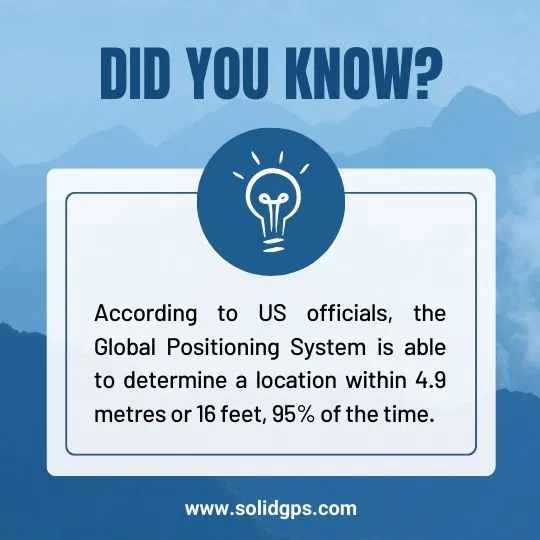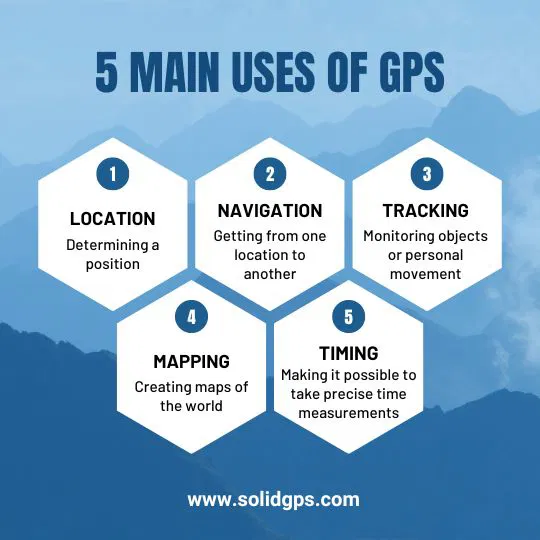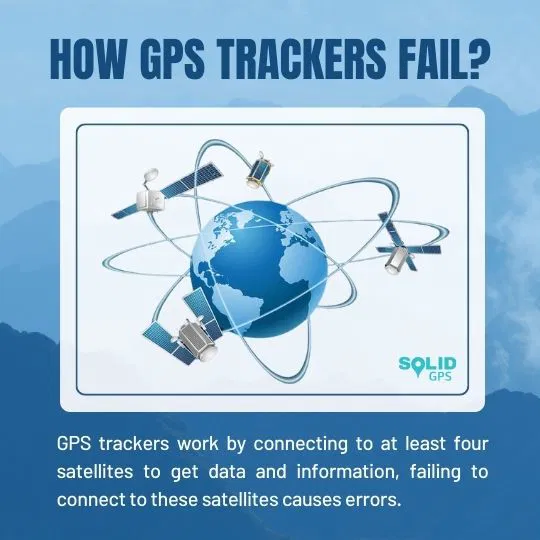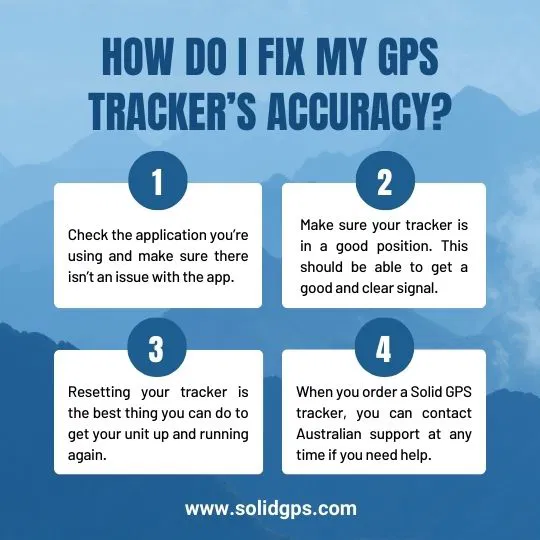Global Positioning System (GPS) technology has become a cornerstone of modern navigation, essential for tracking vehicles, assets, and even loved ones with impressive precision.
Using signals from a constellation of satellites orbiting Earth, GPS devices help determine an object’s or person’s location.
However, even with sophisticated technology, there are factors that can impact GPS accuracy.
Here, we’ll explore how GPS accuracy works, where it excels, and how it can sometimes fall short.

The Core Mechanism of GPS Accuracy
At the heart of GPS functionality is a technique called trilateration.
For a GPS device to calculate its position on Earth, it needs signals from at least four satellites.
These satellites send time-stamped signals to the GPS receiver, which uses the time it takes for each signal to reach it to determine its exact location.
With trilateration, GPS devices can usually pinpoint their position within 3 to 15 metres of accuracy—a range that can vary depending on device quality, technology type, and environmental conditions.
Assisted GPS (A-GPS) for Improved Urban Accuracy
In dense urban areas, buildings often block satellite signals, making it difficult for GPS devices to lock onto their location.
To counter this issue, many devices employ Assisted GPS (A-GPS) technology.
A-GPS combines data from GPS satellites with information from cell towers and Wi-Fi networks, allowing the device to estimate its position even when satellite signals are weak.
A-GPS significantly improves accuracy in cities with tall buildings, providing a quicker location lock that’s particularly useful in urban settings.
Standalone GPS Trackers vs. Smartphones: Which Is More Accurate?
Not all GPS-enabled devices are created equal.
Standalone GPS trackers are generally more accurate than smartphones, as they are purpose-built for tracking and navigation. These dedicated trackers can sometimes achieve accuracy within 1 metre under optimal conditions.
Smartphones, while convenient, typically offer an accuracy range between 3 to 5 metres.
One reason for this difference is that smartphones run multiple applications simultaneously, which can interfere with GPS performance.
In contrast, standalone trackers are optimised solely for location tracking, allowing them to maintain a more consistent and accurate reading.
For individuals and businesses that rely on precise location data—such as fleet managers or security personnel—a dedicated GPS tracker is often the best choice.
Business Applications of High-Accuracy GPS and Cost Savings
In various industries, high-accuracy GPS tracking isn’t just a convenience—it’s a business necessity.
Logistics, construction, and field service industries all rely on GPS tracking to streamline operations, improve resource allocation, and monitor employee activities.
In fleet management, GPS tracking helps companies ensure that drivers follow planned routes, reduce fuel costs, and avoid delays. With precise GPS tracking, logistics companies can meet delivery schedules more reliably and track valuable assets in real-time.
Accurate GPS tracking can also have a substantial financial impact.
For example, AV Decking, a construction company, implemented a GPS-based time-tracking system and saved up to $200,000 annually by reducing payroll errors and time theft.
This case demonstrates the real cost savings and productivity gains that high-accuracy GPS tracking can offer businesses.

Differential GPS (DGPS) for High-Precision Needs
For applications requiring extreme precision, such as scientific research and land surveying, Differential GPS (DGPS) is the preferred solution.
DGPS enhances the accuracy of traditional GPS by using ground-based reference stations to correct signal errors, allowing for measurements down to millimetre precision.
While DGPS is too precise for everyday use, it’s indispensable in fields that demand exact location data, such as environmental monitoring, scientific research, and infrastructure development.
DGPS shows how GPS technology has been adapted to meet specialised needs for millimetre-level accuracy.
The Importance of Battery Life in GPS Devices
Battery life is another critical factor when selecting a GPS device, especially for users in fleet management or asset tracking, where long-term performance is essential.
Dedicated GPS devices generally offer significantly longer battery life than smartphones, lasting for weeks or even months on a single charge.
This extended battery life is essential for businesses, as it reduces downtime, minimises maintenance, and ensures that tracking is uninterrupted.
For instance, fleet managers rely on GPS devices with long battery lives to track vehicles continuously.
Frequent recharging could cause gaps in data, making extended battery life a vital feature for reliable fleet management and other long-term tracking applications.
Safety and Security Applications of GPS Tracking
GPS tracking technology is also widely used in public safety and personal security.
Law enforcement agencies frequently rely on GPS data to investigate criminal activities, track suspects, and reconstruct crime scenes.
In fact, GPS evidence has become a critical component in some criminal cases, providing location-based proof that can confirm or refute alibis.
Personal GPS trackers also help individuals monitor the whereabouts of family members and pets.
For example, parents can use GPS to track their children’s locations or to check on elderly relatives, while pet owners use it to keep track of pets that may roam.
These safety and security applications showcase the versatility of GPS as a tool for both personal and public protection, offering peace of mind in a range of scenarios.

How and Why GPS Trackers Fail
Even with advancements, GPS trackers are not immune to error.
Several factors can lead to inaccuracies or failures:
- Environmental Interference: Physical obstacles, such as mountains, tunnels, bridges, and tall buildings, can block or distort GPS signals, leading to temporary inaccuracy.
- Multipath Effect: In urban settings, GPS signals may reflect off buildings or other objects, causing the device to interpret the signals incorrectly and reducing accuracy.
- Signal Loss: When a GPS tracker loses its satellite connection, it may continue logging location data and upload it once the connection is restored. This can lead to gaps in real-time tracking but is generally temporary.
- Infrequent Use: If a GPS tracker hasn’t been used recently, it may take longer to reestablish a connection. This issue can typically be resolved with a secondary activation to recalibrate the device.
While these issues can impact GPS performance, most are temporary or fixable with basic troubleshooting steps.
Troubleshooting GPS Accuracy Issues
If your GPS tracker displays inaccurate data, there are steps you can take to resolve these issues and restore accuracy:
- Check the App: Sometimes, a software issue in the tracking app can cause errors. Restart the app or check for updates to rule out app-related inaccuracies.
- Reset the Device: Power off the tracker for a few minutes and restart it to recalibrate the device.
- Contact Support: For persistent issues, contact the customer support team of your GPS provider. Most providers offer support to troubleshoot or repair devices as needed.
Indoor and Alternative Tracking Technologies
GPS technology is generally limited indoors, as satellite signals struggle to penetrate walls and other indoor structures.
For indoor tracking or areas with obstructed GPS signals, alternative technologies like Bluetooth Low Energy (BLE) beacons and Radio-Frequency Identification (RFID) tags offer useful solutions for tracking within a short range.
While these options lack the range and accuracy of GPS, they are widely used in warehouses, retail stores, and other small, controlled environments where GPS isn’t viable.
BLE and RFID technologies offer a different type of accuracy that complements GPS in scenarios where proximity detection is more critical than wide-area tracking.
By integrating these alternatives, businesses can achieve comprehensive tracking solutions for both indoor and outdoor environments.

Conclusion
GPS technology has transformed modern life, providing essential services across personal, industrial, and public safety applications.
With uses spanning asset tracking, navigation, and safety, GPS offers unmatched accuracy and reliability.
While factors like signal loss and environmental interference can impact performance, advancements such as Assisted GPS, Differential GPS, and alternative tracking technologies like BLE and RFID address these challenges with specialised solutions.
Understanding GPS accuracy, device options, and use cases can help users choose the best solution for their needs.
To better understand GPS technology, its capabilities, and how to troubleshoot common issues, explore our FAQ section.

